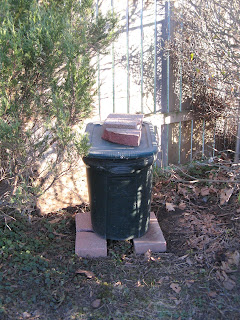 Last year, when I considered making a composter in my backyard, I had the incorrect assumption I had to buy a special bin or container to create this rotting, organic mecca.
Last year, when I considered making a composter in my backyard, I had the incorrect assumption I had to buy a special bin or container to create this rotting, organic mecca.Realizing this was entirely false, I set about making my composting bin this weekend.
Gayla Trail has been blogging You Grow Girl for many years now, but I didn't discover her until I came across her book, by the same name, at the library. She mentions that you can make any container into a composter. After cleaning out my garage recently, I decided that a forgotten garbage pail from the previous owner
s was destined to be my compost bin. It was missing the lid, but I found another orphaned lid and decided that with a cement block on top, I had everything I needed.
Here is what I used to make my compost bin:
- Plastic garbage bin and lid
- Drill with 5/8" bit
- Newspaper
- Dry organics or 'browns' (dried leaves and grass clippings, twigs, straw)
- "Wet" organics or 'greens" (kitchen scraps, coffee grounds, grass clippings)
*NOTE* Do NOT put meat, dairy, animal droppings, oils or fats in your compost bin. This will attract rodents and pests and may make the compost smell really nasty.


Here is what I did, or you can check out step-by-step tips on You Grow Girl:
- Rinse out the can. It wasn't too dirty to begin with, but who knows what was in it in the past. "Clean" compost will be better for your plants also.
- Drill holes in the bottom and sides of the can for drainage and so the compost can 'breathe'.
- I placed my bin in an unused corner of my backyard and up on cement blocks to allow air to circulate beneathe it.
- Rip newspaper in 1 inch wide strips and place in the bottom. Top with a layer of dried leaves (about six inches deep), followed by the 'wet' kitchen scraps.
- Lightly sprinkle water on top. You want enough to make the compost damp, but the contents should not be 'floating'. In springtime, Mother Nature will also help with this process naturally.
That was it! Easy-peasy (this is my new favourite word)!!
Every few weeks, I will need to turn or 'aerate' the compost with a shovel or pitchfork. I also read to bury kitchen scraps in the bin as you add them, and this will speed up the microbial process.



"Easy Peasy Lemon Squeezy" That was Jason's fav for a while. LOL Char
ReplyDeleteHahaha I love it Char!
ReplyDelete